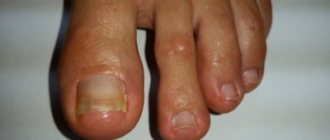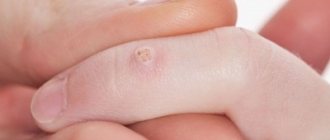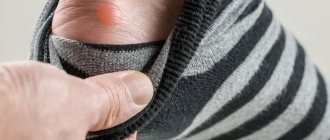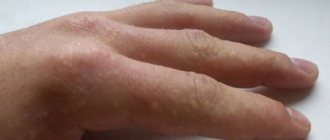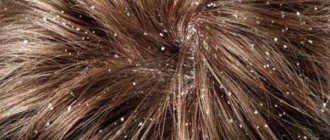Spica is a skin disease caused by a viral infection. Most often, a spine appears on a child’s leg: on the foot, fingers. The growth causes discomfort and pain when moving. Despite this, the wart is often ignored, believing that it can go away on its own. In fact, it is very difficult to get rid of the spine. When the top of the growth is cut off, its lower part continues to grow and cause discomfort.
A baby’s spine is a reason to immediately seek help from a specialist for treatment.
Appearance and locations
At the initial stage, a spine in children looks like a small round or oval lump on the skin with a smooth surface. It doesn't hurt. As the wart progresses, it grows up to 2 cm and begins to cause inconvenience. The wart at stage 2 rises above healthy areas, has a denser structure and a clearly defined contour. The color varies from yellow to greyish, often with dark spots - these are clogged capillaries. Upon closer examination, thread-like formations can be seen inside the growth. Warts often appear in groups. Among them, the largest one stands out - the maternal one. When it is deleted, its children also disappear.
The neoplasm has different zones of location on the human limbs. The areas of greatest friction or pressure suffer the most. The spike appears:
- on the heel of the foot;
- on other parts of the foot, it is especially common to have a spine on a child’s toe;
- on the hands (near the nails, on the fingertips, between the fingers).
Causes
A bunion on a child’s foot occurs as a result of the activity of human papillomavirus types 1 and 4. This virus enters the body through wounds, scratches, and cracks in the skin. When a child with a wound uses other people’s hygiene items, goes to baths, swimming pools, saunas, there is a risk of contracting papillomavirus. In some cases, the virus lies dormant. The following reasons contribute to its manifestation:
Weak immunity, stress, infections, injuries, poor hygiene - become the reason for the development of spines in a child.
- Weakening of the immune system. At this time, dormant microorganisms make themselves known. This reason contributes to the appearance of warts in people suffering from HIV and tuberculosis.
- Stressful situations also disrupt a person's immune balance.
- Hyperhidrosis - excessive sweating contributes to the development of pathogenic microflora on sweaty parts of the body.
- Obesity promotes active sweating.
- Changes in climatic conditions;
- Tight and uncomfortable shoes.
- A fungal infection of the skin provokes a spine on the leg.
- Failure to comply with hygiene rules.
Symptoms of the disease
Sometimes people confuse this growth with a callus. But these are completely different concepts. Unlike calluses, a spine is much more difficult to cure. You can determine a baby's cervical spine by the following parameters:
- Severe pain when pressed.
- It consists of 2 layers - keratinized skin and thread-like processes that go deep into the skin, right down to the muscle tissue.
- Severe itching on an arm or leg.
- The nature of the pain is like being pricked by a thorn. This is where the name wart came from.
- From the first wart, new ones can develop over time. They can merge with the first one.
- When getting rid of a growth at home, a relapse often occurs, because its lower ball remains.
It is better to entrust the treatment of spines in a child to specialist dermatologists.
Diagnosis of spine in a child
To diagnose a spine, you need to visit a dermatologist. The specialist examines the child’s foot, conducts dermatoscopy, during which he studies the structure and composition of the growth.
The examination procedure helps to establish the correct diagnosis and distinguish a plantar wart from cutaneous hyperkeratosis and calluses. The diagnosis is made free of charge in a children's clinic at the place of residence or in a paid medical center (appointment cost from 500 rubles).
To determine the depth of the spine, an ultrasound scan of the foot is performed (from 600 rubles). As an additional study, a PCR test can be prescribed to determine the presence of antibodies to HPV in the blood and the type of infection (from 1,500 rubles).
In case of severe growth of a plantar wart or the presence of HPV type 2 in the baby’s body, an additional histological examination of parts of the growth is prescribed to exclude the malignant nature of the neoplasm.
How to treat a wart?
Removing spines on a child’s feet or hands requires consultation with a dermatologist. A specialist based on the condition of the tumor and the extent of its spread prescribes appropriate treatment for the spine. It can be removed with medication and surgery. There are 3 methods of drug therapy: necrotizing drugs, keratolytics, freezing agents.
Medication
Necrotizing drugs
Their action is based on cauterization and necrosis of the growth in the child. This action is caused by the action of aggressive acids. Medicines of this type are not used to remove a bunion on the foot of young children. Superclean liquid is one of this group of products. It should be applied with a cotton swab to the steamed wart, having previously lubricated healthy areas of the skin with the cream. Apply the ointment for 2-4 days. In addition to this, this type of medicine includes Ferezol and Solcoderm.
Keratolics
They act more gently. The principle of their action is exfoliation of keratinized tissues of the growth. Argonica silver ion concentrate is a keratolic. This brown liquid contains distilled water and cluster silver. Before using the drug, you should consult a dermatologist, because the drug has contraindications - pregnancy, lactation and individual intolerance. “Argonica” is applied to steamed skin and sealed with a band-aid. Use it until the spine is completely removed. A lapis pencil was also created on the basis of silver.
You can get rid of spines in a child by freezing the area with a special medication.
Freezing agents
"Cryofama" is one of these drugs. He freezes the growth with liquid nitrogen. Using a special brush, apply the product to the affected area and press for 10 seconds. During the process, a burning sensation occurs, but this is a normal reaction to the cold. After the procedure, the burning sensation disappears, the skin acquires a normal color. After 10 days, the spine disappears, and normal skin appears in its place.
Surgical methods for removing a spine in a child
When pharmaceutical drugs are powerless, special medical procedures can help treat spine in a child. This category includes:
- Laser removal is the most common and effective method. It is painless and the scar is almost invisible.
- Cutting with a scalpel. As a result, a scar remains on the foot. There are cases of relapse of the disease.
- The wart is removed using high-frequency current burning. After the procedure, a wound appears that is disinfected.
- Cryodestruction - freezing the spikegi with liquid nitrogen. The method is a little painful, so it is better not to use it to remove a spine on a finger.
How to remove a thorn using folk remedies?
Lotions made from herbs, rhizomes, and fruits are good for healing spines in a child.
This method of treatment is considered an alternative to medications and is often used. In this case, you need to be careful to prevent burns and other injuries. To help remove the spine:
- Dandelion juice, celandine. They apply it to problem areas several times a day until the growth is completely removed.
- Horseradish helps remove the spine on the foot, on the sole. Its leaves are dried and ground into powder. Then pour hot water and leave for 2 days. Socks are soaked in the emulsion, they are put on and plastic bags are placed on top. The procedure is done at night, and in the morning the feet are removed and washed.
- Cement. With its help, the spine on the palm and finger is removed in a few days. Cement powder is rubbed into the sore spot and held until completely dry.
- Bulb. It is grated and soaked in vinegar for 2 hours. Then they bandage it until the growth occurs.
- A paste of raw potatoes, which is glued to the wart with an adhesive plaster, is wrapped in cellophane. It is better to do manipulations before bedtime.
- Cauterization with propolis will help quickly remove the growth.
Minimally invasive therapy for spine removal
Children are recommended to have lesions removed using minimally invasive methods. Their removal is done in one go and there is no need to torment children with constant cauterizations. The procedures are performed under local anesthesia in an operating room. They will be performed by a surgeon.
How to remove and get rid of growths using a laser?
Removing spines using a laser in children is considered the most convenient, reliable and painless method. The following types of laser systems are currently used to remove skin lesions:
- erbium laser;
- installation of impulse action;
- CO2 laser.
They destroy tumor cells, evaporate fluid from the cells and seal the vessels feeding the tumor.
The advantages of the technique include:
- safety;
- sterility;
- the wound heals quickly;
- the ability to control the depth of beam penetration;
- does not leave scars after use;
- Removes formation completely in one application.
Getting rid of the spine is carried out under the influence of local painkillers. Then the location of the growth is treated with an antiseptic solution. Afterwards, a laser effect is performed that destroys the cells.
Areas of healthy skin are not affected. After the procedure, an antiseptic is again applied to the wound. A crust forms at the site of exposure, which disappears on its own after two weeks.
How to remove it with liquid nitrogen?
Cryodestruction is considered the most popular method of removing spines. In general, the procedure is easily tolerated by the patient, but there is some pain, as the doctor presses on it during the process of cauterizing the growth.
The procedure is carried out using a special cryo applicator that contains liquid nitrogen. The impact on education lasts no more than thirty seconds. When exposed, the spine turns white and hardens.
After about an hour, the affected area becomes swollen and red. Subsequently, a bubble is inflated at this place, it goes away within a week.
A crust forms at the wound site. Ten days later it disappears after the wound heals. It cannot be removed, as suppuration will occur and a scar may form. If the formation has a deep cone, up to four procedures may be required.
Electrocoagulation
The action of this method is based on the destruction of altered skin cells under the influence of electric current. Before using it, local anesthesia is administered.
Not only the spine itself is affected, but also a small area of healthy tissue surrounding it. This is necessary to prevent the spread of the virus. After the wound heals, a small, inconspicuous scar forms.
Prevention of infection
To avoid the appearance of spines on your feet, you need to remember the rules of hygiene. The following recommendations will help with this:
Prevention of spines in a child involves hygiene, healthy eating, and strengthening the immune system.
- Do not walk barefoot in swimming pools, bathhouses, or on beaches.
- Don't wear other people's shoes. If this happens, you need to wash things thoroughly.
- Walk only in comfortable and appropriately sized shoes.
- Proper nutrition.
- Keep shoes and feet clean.
- Strengthen immunity. Eliminate the reasons that reduce it.
- Try to avoid injury to the skin.
Spine in a child is a serious problem. You shouldn’t wait until the wart goes away on its own, but take action right away. It must be remembered that thorny is a benign neoplasm, which in rare cases can progress and develop into a malignant tumor. In addition, this growth causes a lot of inconvenience and pain, which ruin a person’s life.
Are they surgically removed for children?
Surgical removal of spines in children is carried out only if it is large in size and has a very deep cone that penetrates into the thickness of the skin layers, or if there are several formations at once. It is performed under local anesthesia.
The doctor uses a scalpel to remove the growth body and surrounding tissue. Then stitches are applied. Now this technique is rarely used, since after it a pronounced scar is formed, and there is a high probability of relapses and suppuration.
